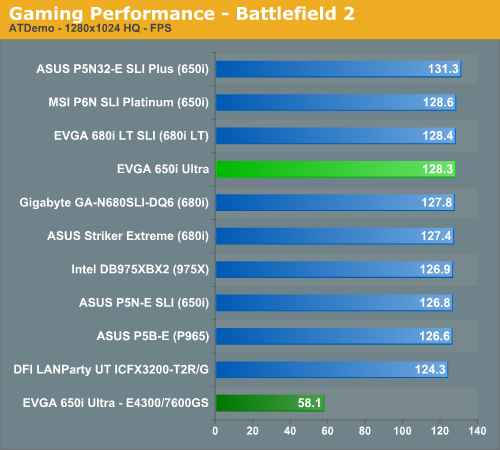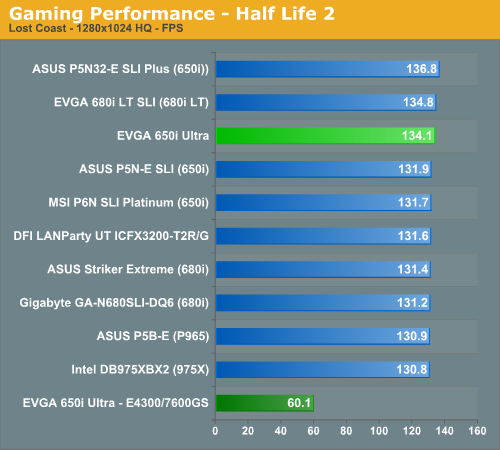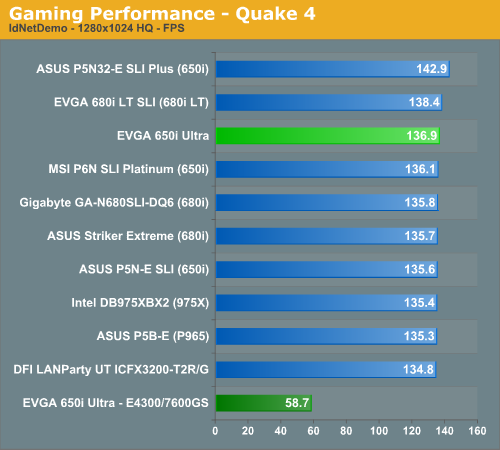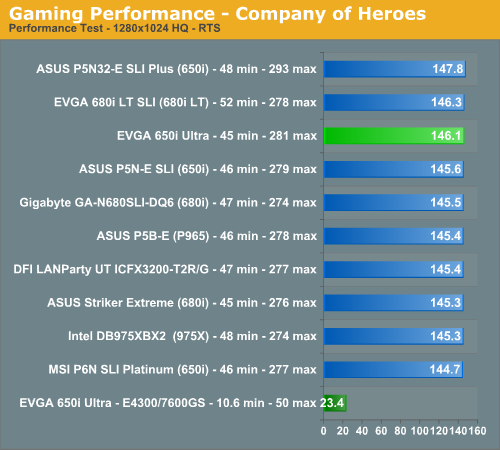EVGA nForce 650i Ultra: Performance on a Budget
by Gary Key on April 10, 2007 2:00 AM EST- Posted in
- Motherboards
Standard Gaming Performance
standard 1280x1024 resolution without antialiasing enabled (and generally without anisotropic filtering, though that varies by game). Given the number of users that run 19" LCDs these days, 1280x1024 represents one of the most commonly used resolutions. We could certainly increase the amount of eye candy being displayed in most of the games, but as this is a motherboard benchmark we aren't particularly interested in maxing out the graphics cards in our tests.
Battlefield 2
This benchmark is performed using DICE's built-in demo playback functionality with additional capture capabilities designed in house. During the benchmark, the camera switches between players and vehicles in order to capture the most action possible. There is a significant amount of smoke, explosions, and vehicle usage as this a very GPU intensive Battlefield 2 benchmark. We run Battlefield 2 using the highest quality graphics settings available in the video settings.

Half Life 2: Lost Coast
We use the built-in timedemo feature to benchmark the game. Our timedemo consists of starting at the bottom of the hill near the lake and ending in the old church. The Source engine timedemo feature is similar to the nettimedemo of Id's Doom 3 engine, in that it plays back more than just the graphics. The highest visual quality settings possible were used with HDR enabled for our tests.

Quake 4
We utilize the nettimedemo test rather than the timedemo option for motherboard benchmarking of Quake 4. To be clear, this means our test results focus mostly on the sort of performance users will experience during actual game play. Additionally, Quake 4 limits frame rate to 60 fps during gameplay whether or not VSync is enabled. Our benchmark utilizes the IdNetDemo. This demo includes mainly outdoor areas with numerous players trying to wipe each other out. We tested the game with High Quality settings (uncompressed normal maps), and we enabled all the advanced graphics options except for VSync.

Company of Heroes
Company of Heroes is a very GPU intensive game and also requires a hefty CPU at times. The game contains a built-in performance test that utilizes the game engine to generate several different action scenes along with a coffee argument as a sideline distraction before the war starts. We found the performance test gives a good indication of how well your system will perform throughout the game. The benchmark may average slightly faster than the worst case battle scenarios, but the difference between gameplay and the cut scene is less than 20%.

Gaming Summary
We still think it is basically a tossup as to which chipset you select for a gaming machine with feature differences such as SLI or CrossFire potentially being a deciding factor if those technologies are important to you. All of the results are very close and during actual game play we could not tell any real differences between the boards. Our EVGA 650i Ultra board provided top three results but still could not keep pace with the ASUS Plus board due to that board's extremely aggressive sub-timings.
We did not experience any issues during testing or during game play with the EVGA board at stock settings with our particular memory choice. We did encounter some issues with our budget to mid-range memory modules but once we relaxed CAS Latency and tRP timings the board was very stable with a wide range of memory modules. We generally play over a dozen different games for at least a couple of hours on each board to ensure there are no issues such as overheating, stuttering, or network issues when playing online with a various combination of components.
standard 1280x1024 resolution without antialiasing enabled (and generally without anisotropic filtering, though that varies by game). Given the number of users that run 19" LCDs these days, 1280x1024 represents one of the most commonly used resolutions. We could certainly increase the amount of eye candy being displayed in most of the games, but as this is a motherboard benchmark we aren't particularly interested in maxing out the graphics cards in our tests.
Battlefield 2
This benchmark is performed using DICE's built-in demo playback functionality with additional capture capabilities designed in house. During the benchmark, the camera switches between players and vehicles in order to capture the most action possible. There is a significant amount of smoke, explosions, and vehicle usage as this a very GPU intensive Battlefield 2 benchmark. We run Battlefield 2 using the highest quality graphics settings available in the video settings.

Half Life 2: Lost Coast
We use the built-in timedemo feature to benchmark the game. Our timedemo consists of starting at the bottom of the hill near the lake and ending in the old church. The Source engine timedemo feature is similar to the nettimedemo of Id's Doom 3 engine, in that it plays back more than just the graphics. The highest visual quality settings possible were used with HDR enabled for our tests.

Quake 4
We utilize the nettimedemo test rather than the timedemo option for motherboard benchmarking of Quake 4. To be clear, this means our test results focus mostly on the sort of performance users will experience during actual game play. Additionally, Quake 4 limits frame rate to 60 fps during gameplay whether or not VSync is enabled. Our benchmark utilizes the IdNetDemo. This demo includes mainly outdoor areas with numerous players trying to wipe each other out. We tested the game with High Quality settings (uncompressed normal maps), and we enabled all the advanced graphics options except for VSync.

Company of Heroes
Company of Heroes is a very GPU intensive game and also requires a hefty CPU at times. The game contains a built-in performance test that utilizes the game engine to generate several different action scenes along with a coffee argument as a sideline distraction before the war starts. We found the performance test gives a good indication of how well your system will perform throughout the game. The benchmark may average slightly faster than the worst case battle scenarios, but the difference between gameplay and the cut scene is less than 20%.

Gaming Summary
We still think it is basically a tossup as to which chipset you select for a gaming machine with feature differences such as SLI or CrossFire potentially being a deciding factor if those technologies are important to you. All of the results are very close and during actual game play we could not tell any real differences between the boards. Our EVGA 650i Ultra board provided top three results but still could not keep pace with the ASUS Plus board due to that board's extremely aggressive sub-timings.
We did not experience any issues during testing or during game play with the EVGA board at stock settings with our particular memory choice. We did encounter some issues with our budget to mid-range memory modules but once we relaxed CAS Latency and tRP timings the board was very stable with a wide range of memory modules. We generally play over a dozen different games for at least a couple of hours on each board to ensure there are no issues such as overheating, stuttering, or network issues when playing online with a various combination of components.










18 Comments
View All Comments
kentster2 - Wednesday, April 18, 2007 - link
This motherboard sounds perfect for me but I can't find it anywhere. In fact I can't find any boards based on the 650i Ultra chipset available anywhere. I did find the specs on an MSI board based on this chipset but again no availability. Does anyone know when the general availability will be for these boards?yyrkoon - Thursday, April 12, 2007 - link
Still does not compare to the best AM2 'budget' board out there. Add the following, and it would do good I think:1) Heatpipe cooled chipset
2) Either one more PATA port, or 2 more SATA ports for a total of 8 drives
3) Firewire ( not supported ?! )
4) Overclocking options out the wazzu, with memeory voltages capable of 3.0v
Are the PATA ports controlled by the 430MCP ? It seems that way, going by the features list. If this is the case, WHY leave out a PATA port ? It does not make sense. These four things I've mentioned above are not too much to ask, ABIT has already proven that with the NF-M2 nView, and places like newegg, ZZF, etc can not seem to keep these boards in stock ! What gives . . .
kmmatney - Wednesday, April 11, 2007 - link
it;s obvious that having a high priced sound card will help out with frame rates, but what about a cheaper card? Would a $27 Creative Audigy SE provide the same speed benefits by taking the load from the cpu?Gary Key - Wednesday, April 11, 2007 - link
The SE will provide frame rates that are on average about 2~3% worse than the X-FI in my experiences.lopri - Tuesday, April 10, 2007 - link
Gary's measure is remarkably similar to my observations on EVGA 680i board. (Interesting because the chips used on the 680i SLI are different from 650i Ultra) Without active cooling, I saw SPP temp rising to 100C(!) and MCP to 80C. This will not only cause instability (especially mated with other high-end components) but likely shorten the lifespan of the board. Even more worrisome is that the ever-increasing popularity of those L-shaped HSFs. These HSFs provide practically zero air-flow on the board's hot (i mean, HOT) spots and therefore the heat keeps building up.
I think NV at this point just assume that their target audience are *enthusiasts* in that:
1. Enthusiasts today just accept that a new motherboard/chipset is basically a beta product and expect fix/patches via BIOS updates and/or hardware revision.
2. Enthusiasts tend to employ their own cooling solution anyway.
And that's exactly what I've done up to this date. Every single NV chipset board I bought the first thing I did was replacing stock chipset/VRM cooling with aftermarket stuff.
And I'M TIRED OF IT.
This board may be selling for $99, but in order for you to build your main rig with a peace of mind on it, you will need an aftermarket cooling for the missing SB HSF (how dare they leave it wide open like that is beyond me) and the paltry NB heatsink for a heavier one. There goes extra $20~30 quite easily.
To my eyes, this board cut so many corners and definitely not worth $99. $70~80 maybe. And I do think that's how much it'll sell for in less than a month.
nullpointerus - Wednesday, April 11, 2007 - link
When it's included, active cooling's crap anyway. The little NB/SB fans last a few months at most before giving out completely. Motherboard makers should get in touch with Zalman or somebody like them and get some decent quality HSF's on these boards.jay401 - Wednesday, April 11, 2007 - link
Totally agree! It would be stupid to buy a motherboard that requires you buy other items just to ensure stable operation and longevity.Scarceas - Tuesday, April 10, 2007 - link
Really, who needs 2.2V? If you have RAM that needs that much voltage, chances are you paid more money for it, and the board you are looking to use it with will probably not be a budget board.WT - Tuesday, April 10, 2007 - link
I have an eVGA N41 board, so I want to like this thing, but looking at this 650 board .. blechhh .. talk about plain Jane !! It looks like a straight reference board or an Intel board ! Regardless of looks, performance is what we want, so I would refer anyone looking at this board to read Anand's earlier article on the MSI P6N Platinum and see if that isn't a better fit for your needs. The extra $40-50 is well justified (in my case at least) with the better cooling setup on the MSI board as well as Firewire (just bought a miniDV camcorder) so give that a read as well.If the MSI Plat is priced too high, then check out the FI board priced at $108 at popular vendors websites.
Pirks - Tuesday, April 10, 2007 - link
Gary, E6300 has TWO megabytes of cache, not FOUR